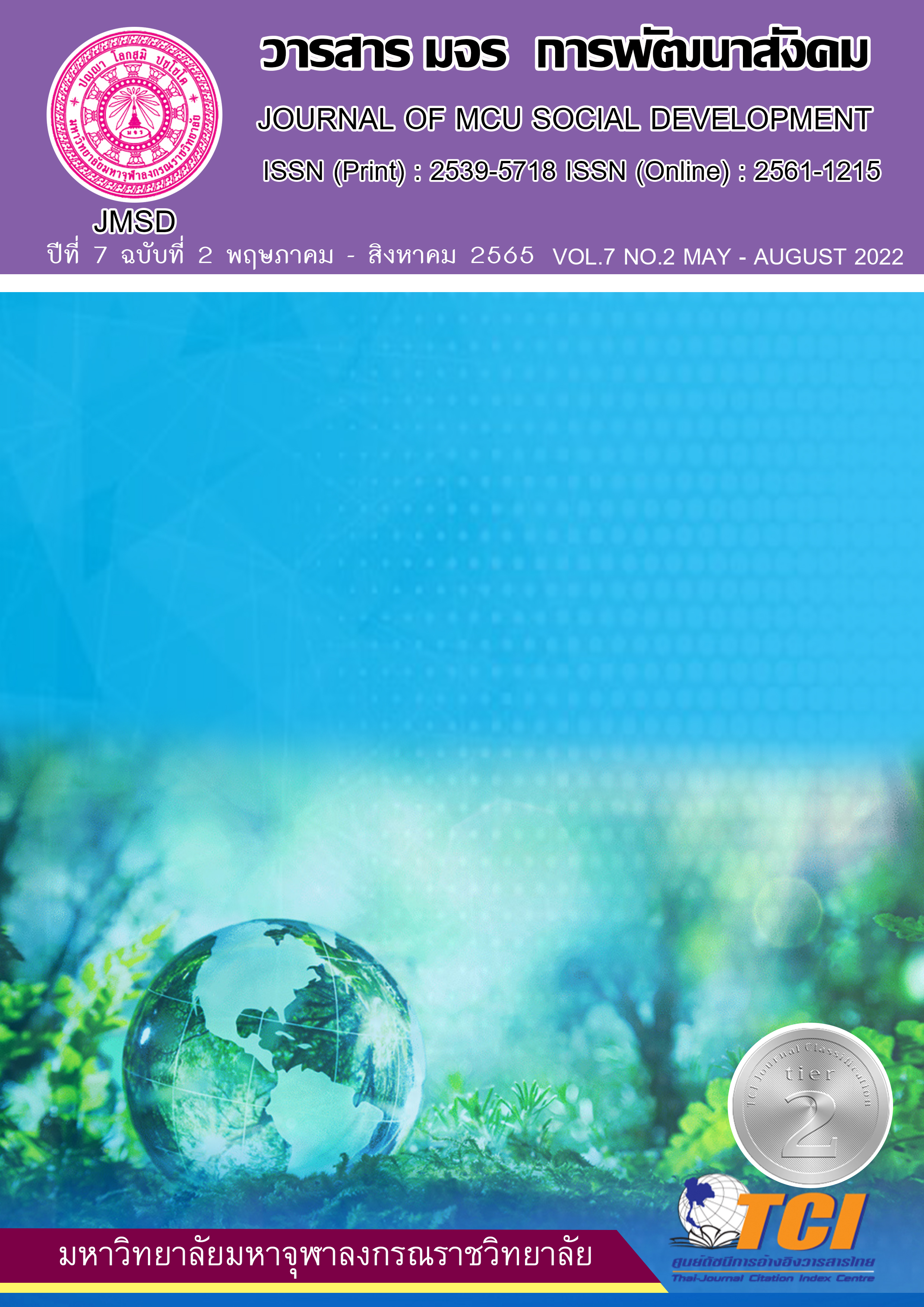รูปแบบและเครือข่ายการเผยแผ่พระพุทธศาสนาเชิงรุก
คำสำคัญ:
พระธรรมจาริก, รูปแบบการเผยแผ่พระพุทธศาสนา, ราษฎรบนพื้นที่สูงบทคัดย่อ
บทความวิจัยนี้เป็นส่วนหนึ่งของดุษฎีนิพนธ์เรื่อง รูปแบบและเครือข่ายการเผยแผ่พระพุทธศาสนาเชิงรุกของพระธรรมจาริกในสังคมไทย มีวัตถุประสงค์ 1) เพื่อศึกษารูปแบบเครือข่ายการเผยแผ่พระพุทธศาสนาเชิงรุก ของพระธรรมจาริกในสังคมไทย 2) เพื่อพัฒนากิจกรรมและเครือข่ายการเผยแผ่พระพุทธศาสนาเชิงรุก ของพระธรรมจาริกในสังคมไทย 3) เพื่อเสริมสร้างรูปแบบเครือข่ายการเผยแผ่พระพุทธศาสนาเชิงรุก ของพระธรรมจาริกในสังคมไทย การวิจัยครั้งนี้เป็นการวิจัยแบบผสมผสาน (Mixed Methods Research) มีผู้ให้ข้อมูลสำคัญ จำนวน 82 ท่าน คือ พระผู้บริหาร จำนวน 7 รูป พระธรรมจาริก 69 รูป และผู้ทรงคุณวุฒิที่ 6 ท่าน ผลการศึกษาพบว่า
- รูปแบบการเผยแผ่พระพุทธศาสนาของพระธรรมจาริก มี 3 รูปแบบ 1) รูปแบบการเผยแผ่พระพุทธศาสนาของพระธรรมจาริก ตามภารกิจโครงการพระธรรมจาริก 2) รูปแบบการเผยแผ่พระพุทธศาสนาของพระธรรมจาริกด้วยจิตอาสา 3) รูปแบบการเผยแผ่พระพุทธศาสนาแบบทั่วไป
- การพัฒนากิจกรรมและเครือข่ายการเผยแผ่พระพุทธศาสนาเชิงรุกของพระธรรมจาริกในสังคมไทย เป็นการคัดเลือกพระธรรมจาริก จำนวน 69 รูป มาอบรมพัฒนาศักยภาพ ผ่านกระบวนการพัฒนา 4 ด้าน คือ
1) กระบวนการเสริมสร้างความรู้แก่พระธรรมจาริก 2) กระบวนการเสริมสร้างทักษะการเผยแผ่พระพุทธศาสนาเชิงรุกแก่พระธรรมจาริก 3) กระบวนการกลุ่มและภาคีเครือข่าย 4) กระบวนการการมีส่วนร่วมของทุก
3. การเสริมสร้างรูปแบบและเครือข่ายการเผยแผ่พระพุทธศาสนาเชิงรุกของพระธรรมจาริกในสังคมไทย มีการเสริมสร้างรูปแบบดังนี้ 1) รูปแบบการเผยแผ่พระพุทธศาสนาโดยทั่วไป 2) รูปแบบในการใช้หลักสาธารณสงเคราะห์ 3) รูปแบบการสร้างภาคีเครือข่ายการทำงานอย่างมีส่วนร่วม 4) รูปแบบใช้กิจกรรมนำศรัทธา ร่วมกับเครือข่าย 3 รูปแบบ คือ 1) เครือข่ายเชิงพื้นที่ 2) เครือข่ายเชิงประเด็นกิจกรรม 3) เครือข่ายแบ่งตามโครงสร้างหน้าที่
เอกสารอ้างอิง
กรมการศาสนา กระทรวงวัฒนธรรม. ความรู้ศาสนาเบื้องต้น. พิมพ์ครั้งที่ 2. กรุงเทพมหานคร : โรงพิมพ์ชุมนุมสหกรณ์การเกษตรแห่งประเทศไทย จำกัด,2557.
บุญมี แท่นแก้ว. พระพุทธศาสนาในเอเชีย. กรุงเทพมหานคร : โอเดียนสโตร์, 2548.
นฤมล นิราทร. การสร้างเครือข่ายการทำงาน: ข้อควรพิจารณาบางประการ. กรุงเทพฯ: โครงการระหว่างประเทศว่าด้วยการขจัดปัญหาการใช้แรงงานเด็ก, 2543.
พระมหาสุทิตย์ อาภากโร (อบอุ่น). เครือข่าย : ธรรมชาติ ความรู้ และการจัดการ. กรุงเทพฯ: โครงการ เสริมสร้างการเรียนรู้เพื่อชุมชนเป็นสุข, 2547.
พระพรหมคุณาภรณ์ (ปอ.ปยุตฺโต). จาริกบุญ-จารึกธรรม. กรุงเทพมหานคร : บริษัทพิมพ์สวย จำกัด,2558.
พ.ต.ท. นาวิน วงศรัตนมัจฉา. “ผลสัมฤทธิ์การเผยแผ่พระพุทธศาสนาในกลุมชาติพันธุลีซูของพระธรรมจาริก” . วิทยานิพนธ์พุทธศาสตรดุษฎีบัณฑิต. บัณฑิตวิทยาลัย : มหาวิทยาลัยมหาจุฬาลงกรณราชวิทยาลัย, 2554.
พระอรุณเมธี พุทธิภัทรานนท์ และคณะ. “ปัจจัยที่ส่งผลต่อการพัฒนาชุมชนบนพื้นที่สูงของโครงการพระธรรมจาริกในพื้นที่ภาคเหนือ”. ดุษฎีนิพนธ์การบริหารการพัฒนา. บัณฑิตวิทยาลัย: มหาวิทยาลัยนอร์ท-เชียงใหม่, 2558.
พระตาล ญาณธโร (สิงห์ทอง). “รูปแบบการเผยแผ่พระพุทธศาสนาของพระธรรมจาริกในสองทศวรรษหน้า”. วิทยานิพนธ์พุทธศาสตรมหาบัณฑิต. บัณฑิตวิทยาลัย: มหาวิทยาลัยมหาจุฬาลงกรณราชวิทยาลัย, 2558.
พีร์ พงศ์พิพัฒนพันธุ์. พุทธศาสนาเพื่อสังคมในโลกตะวันตก . [ออนไลน์], แหล่งเข้าถึง: https://th-th.facebook.com/TungKulaRongHaiProject/posts/ 8457080 52150820/, [28 เมษายน 2563].
สถานเอกอัครราชทูต ณ กรุงนิวเดลี. ประวัติพระพุทธศาสนาในอินเดีย. [ออนไลน์], แหล่งที่มา: http://newdelhi.thaiembassy.org/th/useful-knowledge-th/pilgrimag-wat-thai-th/buddhism-history-in-india-th/ [4 เมษายน 2562].
ดาวน์โหลด
เผยแพร่แล้ว
รูปแบบการอ้างอิง
ฉบับ
ประเภทบทความ
สัญญาอนุญาต
ลิขสิทธิ์ (c) 2022 มจร การพัฒนาสังคม

อนุญาตภายใต้เงื่อนไข Creative Commons Attribution-NonCommercial-NoDerivatives 4.0 International License.



